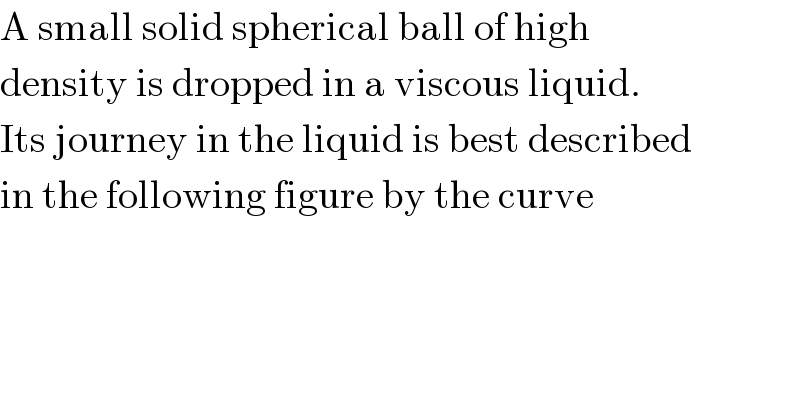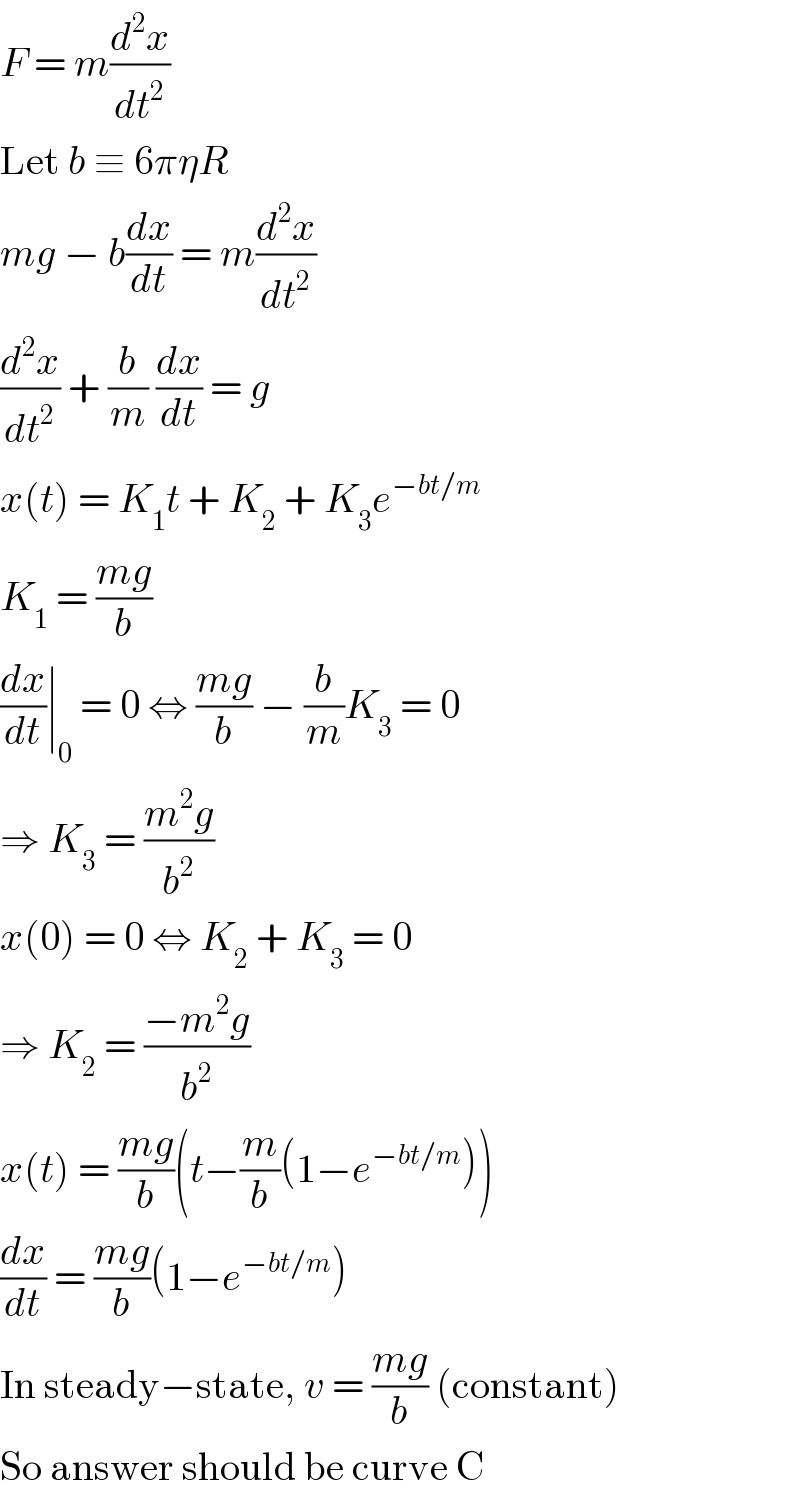
Question Number 20973 by Tinkutara last updated on 09/Sep/17

$$\mathrm{A}\:\mathrm{small}\:\mathrm{solid}\:\mathrm{spherical}\:\mathrm{ball}\:\mathrm{of}\:\mathrm{high} \\ $$$$\mathrm{density}\:\mathrm{is}\:\mathrm{dropped}\:\mathrm{in}\:\mathrm{a}\:\mathrm{viscous}\:\mathrm{liquid}. \\ $$$$\mathrm{Its}\:\mathrm{journey}\:\mathrm{in}\:\mathrm{the}\:\mathrm{liquid}\:\mathrm{is}\:\mathrm{best}\:\mathrm{described} \\ $$$$\mathrm{in}\:\mathrm{the}\:\mathrm{following}\:\mathrm{figure}\:\mathrm{by}\:\mathrm{the}\:\mathrm{curve} \\ $$
Commented by Tinkutara last updated on 09/Sep/17

Answered by dioph last updated on 09/Sep/17

$${F}\:=\:{m}\frac{{d}^{\mathrm{2}} {x}}{{dt}^{\mathrm{2}} } \\ $$$$\mathrm{Let}\:{b}\:\equiv\:\mathrm{6}\pi\eta{R} \\ $$$${mg}\:−\:{b}\frac{{dx}}{{dt}}\:=\:{m}\frac{{d}^{\mathrm{2}} {x}}{{dt}^{\mathrm{2}} } \\ $$$$\frac{{d}^{\mathrm{2}} {x}}{{dt}^{\mathrm{2}} }\:+\:\frac{{b}}{{m}}\:\frac{{dx}}{{dt}}\:=\:{g} \\ $$$${x}\left({t}\right)\:=\:{K}_{\mathrm{1}} {t}\:+\:{K}_{\mathrm{2}} \:+\:{K}_{\mathrm{3}} {e}^{−{bt}/{m}} \\ $$$${K}_{\mathrm{1}} \:=\:\frac{{mg}}{{b}} \\ $$$$\frac{{dx}}{{dt}}\mid_{\mathrm{0}} \:=\:\mathrm{0}\:\Leftrightarrow\:\frac{{mg}}{{b}}\:−\:\frac{{b}}{{m}}{K}_{\mathrm{3}} \:=\:\mathrm{0} \\ $$$$\Rightarrow\:{K}_{\mathrm{3}} \:=\:\frac{{m}^{\mathrm{2}} {g}}{{b}^{\mathrm{2}} } \\ $$$${x}\left(\mathrm{0}\right)\:=\:\mathrm{0}\:\Leftrightarrow\:{K}_{\mathrm{2}} \:+\:{K}_{\mathrm{3}} \:=\:\mathrm{0} \\ $$$$\Rightarrow\:{K}_{\mathrm{2}} \:=\:\frac{−{m}^{\mathrm{2}} {g}}{{b}^{\mathrm{2}} } \\ $$$${x}\left({t}\right)\:=\:\frac{{mg}}{{b}}\left({t}−\frac{{m}}{{b}}\left(\mathrm{1}−{e}^{−{bt}/{m}} \right)\right) \\ $$$$\frac{{dx}}{{dt}}\:=\:\frac{{mg}}{{b}}\left(\mathrm{1}−{e}^{−{bt}/{m}} \right) \\ $$$$\mathrm{In}\:\mathrm{steady}−\mathrm{state},\:{v}\:=\:\frac{{mg}}{{b}}\:\left(\mathrm{constant}\right) \\ $$$$\mathrm{So}\:\mathrm{answer}\:\mathrm{should}\:\mathrm{be}\:\mathrm{curve}\:\mathrm{C} \\ $$
Commented by Tinkutara last updated on 09/Sep/17

$$\mathrm{Thank}\:\mathrm{you}\:\mathrm{very}\:\mathrm{much}\:\mathrm{Sir}! \\ $$
